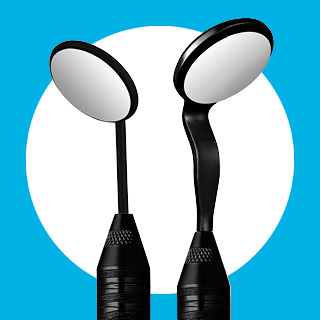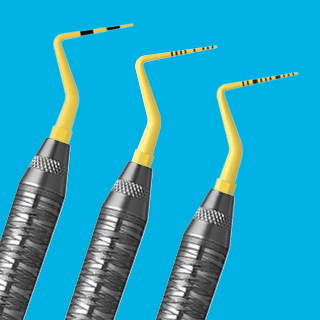Blog
Are Your Diagnostic Instruments Overdue for a Checkup?

Ensuring Your Mirrors, Probes, and Explorers Are in Top Shape
Think back: When was the last time you updated your diagnostic instrumentation?
A diagnostic instrument’s useful lifespan can extend for years. There may be probes and explorers in use right now in some dental offices that performed exceptionally well over time but are truly no longer in optimal condition to advance efficient and vital dental diagnoses.
High-quality diagnostic instruments are indeed durable. But so are teeth, and you wouldn’t advise a patient to skip routine prophylaxis appointments simply because their teeth look and feel fine. The same logic applies to diagnostic instruments.
Regular checkups are as essential for maintaining an effective dental armamentarium as they are for maintaining oral health.
Why Diagnostic Instrument Quality Matters
Dental professionals like you depend on diagnostic instruments to help assess tooth decay, detect caries and calculus, explore hard-to-access areas, measure periodontal pockets, and, in general, form a complete picture of each patient’s oral health.
If your diagnostic instruments are not in good working order, the diagnoses may not be entirely accurate. And as you know, the results can include underdiagnosis, where crucial warning signs of disease are not recognized, or overdiagnosis, with potential overtreatment of asymptomatic conditions. Neither is optimal for you or your patients.
As pandemic regulations loosen and vaccine distribution accelerates, a large number of patients may be returning to your office after having postponed professional dental care for a year or more. Many of them will have symptoms of periodontal disease, decay, and other issues that require immediate attention.
By ensuring your diagnostic instruments are in top shape, you can help these returning patients get back on track and back to optimal dental health as quickly as possible.
How Often Should You Perform a Diagnostic Instrument Checkup?
It’s always a good idea to regularly inspect all your instruments and other dental equipment for damage and defects. We recommend inspecting your diagnostic instruments at least once a year and after any incident that may inflict damage (such as dropping an instrument).
If your practice is currently using any diagnostic instruments that are over one year old, we suggest performing a thorough check-up on them immediately.
What to Look for in a Diagnostic Instrument Check
Mirrors

To diagnose a dental issue, you need to see it. A good mirror helps you do just that, providing a clear, detailed view of all intraoral surfaces, reflecting light into dark crevices, functioning as a retractor, and enabling transillumination.
Over time and in everyday use, dental mirrors can get scratched. Sterilization in pouches, rather than cassettes, readily allows sharp instruments to bump into mirrors resulting in scratching of the reflective surface. Wrapping mirror heads in gauze can allow rough fibers to scratch the mirror surface. Drops and other accidents can cause scratches as well. Investing in an instrument management system like IMS™ Cassettes can provide optimal protection and advance the longevity of your mirror heads.
Mirrors lose some of their reflectivity with each scratch, providing less light to work with along with incomplete or distorted images, all of which can compromise the diagnoses. And, you’ll work harder using a scratched mirror as you’re apt to constantly reposition the mirror and refocus in order to try and get the best, clearest view.
Mirror heads are easily replaceable – allowing you to readily have better visibility and efficiency. If your mirror heads are scratched, we recommend seeking out replacements that offer exceptional levels of brightness, clarity, and reflectivity.
Our High Definition Mouth Mirrors are an excellent choice. They feature a proprietary coating that provides superior brilliance and color for increased visibility in all dental procedures. In tests, these HD mirrors have demonstrated a 113% reflection factor and are 50% brighter than other front surface mirrors. HD mirrors come in single or double-sided versions and are scratch-resistant. Additionally, HD Black Line Mirrors feature a Diamond Like Carbon coating that reduces glare up to 80% when compared to the non-coated stainless-steel mirror head and handle for enhanced visual acuity.
Probes
Probes are the workhorses of the diagnostic dental instrument world since they are used on nearly every patient to gather vital data for determining a diagnosis, such as periodontal pocket depth, attachment level, anatomy configuration, and gingival bleeding.

Probe tips are tapered in order to provide optimal access to narrow pockets. However, thin probe ends can bend or even break by jostling against other instruments in sterilization pouches, improper placement in cassettes, or due to mishandling and accidents. Using a bent probe is like using a bent ruler; you won’t be able to get an accurate reading.
Among the most important features of a dental probe are the markings on the tips, which are finely calibrated for precise measurements. Qulix™ Probes have accurate, smoothly finished black markings which will not chip, flake, or fade. Rather than being laser-etched, the markings are ingrained in the metal – providing for a long-lasting durable instrument.
Alternatively, you might consider opting for resin probe tips which can provide superior visibility and are safe on restorations but do need routine replacement as the markings can fade over time.
HuFriedyGroup offers Colorvue™ Probes, which feature vivid yellow tips with black markings for enhanced contrast to intraoral structures in both natural and implant dentition. The probe tips are safe for use with implants and feature a twist-on design for easy replacement of worn tips. Colorvue™ Markings will wear with normal use, and tips should be replaced about every 30 sterilization cycles.
Explorers
Explorers, necessary in all procedural set-ups, are instruments for which tactile sensitivity is paramount as they are used to detect caries, detect calculus (especially on subgingival tooth surfaces), determine pocket characteristics, and inspect restorations.
While seemingly delicate, a high-quality explorer is both strong and flexible. An explorer should be able to “spring back” to its original shape if, for example, the tip becomes stuck in an occlusal pit and requires extra force to remove. While several types of designs are common, such as the cowhorn, Shepherd’s hook, or TU17, all explorer technique focuses on using the last 1-2mm of the working end. Using a deformed or broken explorer may compromise tactile sensitivity, inhibit adaptation to tooth surfaces, and be uncomfortable for the patient – all affecting optimal diagnoses and favorable treatment outcomes.
Like mirrors and probes, explorers can be damaged, deformed or broken during instrument reprocessing and the best solution to ensure longevity is use of protective cassettes. Explorer tips are particularly vulnerable during reprocessing. If they break, their finely-honed edges can transform into blunt surfaces that can be painful for patients.
HuFriedyGroup explorers are hand-crafted from Duraspond steel, a specially-blended metal alloy that provides flexibility and resilience for even the most precise diagnostic procedures.
Plan Your Diagnostic Instrument Checkup Now
We all know how frustrating it can be when patients push back routine dental visits until their problems are too big to ignore. The earlier you can help patients detect dental health issues, the easier it is to prevent minor conditions from becoming lifelong challenges.
The same goes for your diagnostic instruments. Setting aside an hour or two now, and on a regular basis, to inspect your mirrors, probes and explorers will ensure that your instruments are in proper working condition, allowing you to provide the most comprehensive and accurate diagnoses and treatments for your patients.
All company and product names are trademarks of Hu-Friedy Mfg. Co., LLC, its affiliates or related companies, unless otherwise noted.
